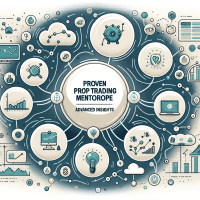Proven Prop Trading Coaching Strategies
In today’s rapidly evolving financial markets, prop trading coaching is emerging as a crucial asset for traders at every level, from junior traders to seasoned quants managing multi-million-dollar portfolios. This article delivers advanced insights into backtesting, risk management, and tool integration, empowering you with actionable strategies to optimize performance and meet evolving regulatory frameworks.
Introduction to Prop Trading Coaching
Prop trading coaching goes beyond traditional trading education by offering hands-on mentorship and in-depth analysis of automated backtesting, live execution, and risk management. Leveraging industry-leading tools—such as TradingView, MetaTrader 5, and NinjaTrader—coaches help traders refine their strategies, evaluate performance metrics like Sharpe ratios and drawdowns, and adhere to compliance requirements like MiFID II and NFA rules.
This comprehensive guide explores advanced strategies to extract maximum value from your prop trading approach. Whether you’re just starting in prop trading training or you’re an experienced professional seeking to refine your tactics, the expertise shared here is designed to elevate your trading performance.

Advanced Backtesting Tools and Their Impact
Backtesting is the backbone of sound prop trading strategies. However, common pitfalls such as overfitting, survivorship bias, and look-ahead bias can distort the results. To mitigate these issues, a combination of traditional and walk-forward optimization techniques is essential.
Tool Comparison: TradingView vs. MetaTrader 5 vs. NinjaTrader
Below is a detailed comparison of the three leading tools used by prop trading firms:
| Tool | Backtesting Features | Data Quality | Integration | Pricing | Use Case |
|---|---|---|---|---|---|
| TradingView | Vectorized backtesting with commission and slippage simulation | Extensive historical data across multiple asset classes | API access and broker integration | Free tier and premium subscription | Ideal for retail and institutional analysis |
| MetaTrader 5 | Event-driven testing with scenario analysis | High-quality forex and CFD data | Direct broker and third party analytics integration | Free demo with affordable live account commissions | Suited for forex and CFD prop firms |
| NinjaTrader | Optimization capabilities with stress testing features | Deep historical and real-time feeds | Fully customizable API, multi-platform compatibility | Free simulation; licensing required for live trading | Best for advanced traders and quants |
These tools not only perform backtesting using historical data, but they also automate the process of parameter optimization, simulation of market conditions, and generate comprehensive performance reports. For instance, walk-forward optimization allows traders to adjust strategies dynamically, ensuring that the backtested performance translates into realistic forward testing outcomes.
Key Strategies for Prop Trading Success
Achieving consistent profitability in prop trading requires an in-depth understanding of both market mechanics and advanced computational techniques. Here are some actionable strategies:
- Embrace Advanced Backtesting Concepts: Use automated parameter optimization and incorporate out-of-sample testing to ensure that your strategies are robust against market changes.
- Integrate Walk-Forward Analysis: Regularly update your models based on new market data to avoid the pitfalls of overfitting.
- Implement Forward Testing: Combine paper trading with real-time analysis to validate backtested strategies before live deployment.
- Utilize Multiple Analytical Tools: Complement your backtesting with technical analysis from TradingView and scenario testing from NinjaTrader to capture market nuances.
By working with experienced prop trading mentors, traders gain insights into differentiating risk management practices and can track performance metrics such as maximum drawdown, Sharpe ratios, and profit factors. This analysis becomes even more critical when balancing team collaboration within a prop firm environment versus individual retail trading setups.
Mitigating Backtesting Pitfalls and Best Practices
Advanced prop trading coaching also involves understanding how to detect and mitigate common backtesting errors:
- Overfitting: Avoid overly complex models by incorporating cross-validation techniques.
- Survivorship Bias: Ensure that your historical data includes delisted or bankrupt entities.
- Look-Ahead Bias: Maintain strict separation between training and testing datasets.
- Data Quality: Use reliable historical price feeds and adjust for corporate actions.
Trading automation strategies, such as those written in Python for Backtrader, can incorporate these checks. For example, a simple code snippet to calculate the Sharpe ratio could look like this:
import numpy as np
def calculate_sharpe(returns, risk_free_rate=0.01):
excess_returns = returns - risk_free_rate
return np.mean(excess_returns) / np.std(excess_returns)
# Example usage:
returns = np.array([0.02, 0.03, -0.01, 0.04])
print('Sharpe Ratio:', calculate_sharpe(returns))
This snippet is just one example of how algorithms play an important role in refining prop trading strategies.

Case Study: Enhanced Strategy Development in a Prop Trading Firm
One prominent prop firm recently overhauled its strategy development process by integrating walk-forward analysis with traditional backtesting. The team faced challenges such as model overfitting and unrealistic simulation of transaction costs. By adopting tools like TradingView for chart analysis and NinjaTrader for stress testing, they were able to:
- Reduce maximum drawdown by 15% over a six-month period.
- Improve Sharpe ratio from 1.2 to 1.8 by fine-tuning risk management protocols.
- Accelerate iteration cycles through automated report generation and parameter sweeps.
This case study demonstrates the essential role of meticulous strategy revision and the benefits of integrating advanced backtesting, forward testing, and real-time data validation in a prop trading environment.
Expert Guidance on Forward Integration and Next Steps
After successful backtesting and scenario analysis, the next critical phase in prop trading is forward testing. Expert coaches stress the importance of combining simulated paper trading with live monitoring to ensure that strategies hold up under real market conditions. Key performance metrics to watch include:
- Maximum Drawdown: Keeping this under stringent limits is crucial for capital preservation.
- Profit Factor: Aiming for values above 1.5 signals robust trade performance.
- Sharpe Ratio: Values above 1.0 often reflect efficient risk-adjusted returns.
Furthermore, integrating findings from automated backtesting tools into a cohesive dashboard allows risk managers and senior quants to monitor the strategy’s health effectively. Pro tips from industry experts include regularly updating models to account for market volatility and regulatory updates such as ESMA guidelines.







